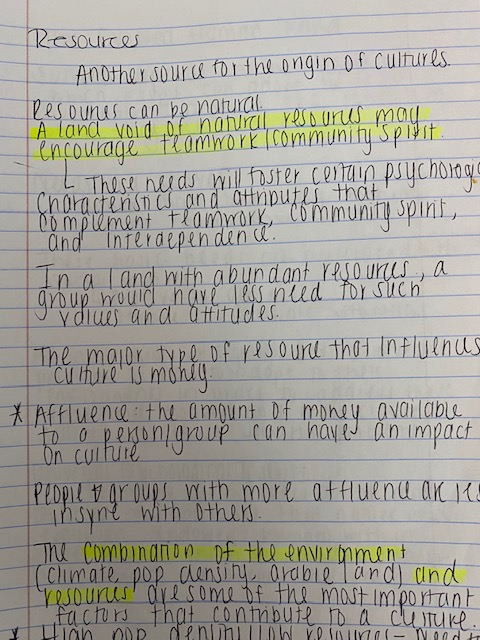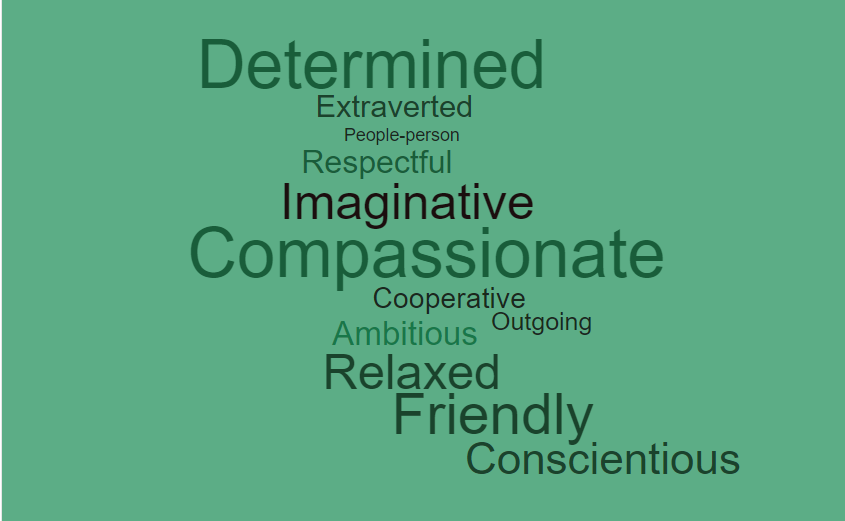Blog 10:
I believe I have achieved all of this course’s goals in at least one way. The first course objective was to “acquaint upper-level undergraduate students with psychological research and theory that examine the influence of culture and psychology throughout the world.” This goal was achieved in Assignment 5, as we were asked to research a peer-reviewed journal that connected our country of choice with our chapter topic in which my chosen country was France and chapter topic was Emotion. The next two objectives: “understand cultural diversity and the impact of culture in human life” and “develop greater understanding of people from other cultures and skills for successfully interacting with them” were met by reading chapter topics that showed the connections and differences between cultures as well as reiterating that information through assignments such as our artifact takeaways. As an example, my artifact takeaway #1 discussed how different cultures symbolize colors in different ways. The final two objectives, “Develop critical thinking skills and apply them to psychological theory and research that examine the influence of culture” and “to be able to make connections, or integrate learning, between courses and to outside experiences” were met through our blog entries. In each entry, we were asked to think critically about questions related to what we studied that week. In blog 8, we were asked about the topic Culture and Emotion. We needed to discuss how those of cultures different from us expressed emotion, and if it was similar or different to our own. We then needed to integrate our learning experience to past experiences such as previous courses. Prior to this course, I knew cultures were diverse but was not sure how much. I was able to learn about the differences in emotion, health, gender, and values to say the least. If there was one thing I could have done differently within this course, it would be to study the material in various ways to ensure I understood the concepts. I have grown academically in this course by now being confident in drawing connections between old and current material. One skill I have gained in this course that will assist me professionally is being able to analyze research material and blogs and express such in my own words.

“Academic Growth”
I chose this picture as I am constantly learning new skills and information that allow me to move up the academic ladder of success.
Blog 9:
One of the top things I have learned within this course relates to self-concept and how it varies within different cultures. Some cultures such as the United States may have a large majority of people who have an independent construal of self, meaning they view themselves as bounded and separated from others. While other cultures such as Japan may have an interdependent construal of self, as they believe the self is unbounded, flexible, and connected to others. Another concept I have learned about is the Self-Determination Theory, a theory focusing on the idea that people from all cultures have the same needs for autonomy, competence, and relatedness that is just expressed differently based on their background. Lastly, I have learned about the existence of cultural display rules and how we unconsciously may follow certain behaviors because our cultural background has determined what is appropriate.
Blog #2 in our course applies to Assignment #2 as we were asked in the former to write about our life values, while in the latter we were asked to review an article by Robert L. Kohls on values that American’s tend to live by. Since I am American, I found myself comparing my values to those on Kohl’s list.
In Cross-Cultural Psychology, evidence for the five-factor model was found based on personality dimensions within and between cultures that are similar. In Psychology of Adulthood and Aging, the five-factor model was used to determine if personality altered over time. Both courses have used the five-factor model for study, but in different ways.

“Making Connections”
This image represents me making connections in my brain about concepts I have learned in this course to what I have learned in other psychology courses.
Blog 8:
As someone who has worked in healthcare settings, I often notice in families of Asian descent how men tend to dominate women and speak for them. For example, my job once had a woman come in who needed to be evaluated for physical therapy. For this to occur, she needed to complete demographic forms to help the therapist pinpoint her issues. However, her husband insisted that he knew her problems and would prefer to complete the forms. The wife stayed silent. Of course, we had to explain that she needed to be the one to speak on her behalf, but it seems it is normalized this way in their culture. Prior to this experience, I learned in my classes how male-dominant many areas of Asia were but did not realize how prevalent it still is today. Their behaviors were different from what I expected. Cultural display rules can help explain this occasion as Asian families in comparison to American families often depend on the male figure to speak and make majority of the decisions for everyone in the family.

https://depositphotos.com/11090205/stock-photo-gender-inequality-balancing-scale.html
“Male Dominance in Asian Cultures”
This image was chosen to represent my personal experience on how much power men seem to have over women in Asian cultures.
Blog 6:
Chapter 6: Culture and Personality brings attention to a theory known as Self-Determination Theory. This theory focuses on the idea that people from all cultures share the same psychological needs for autonomy, competence, and relatedness. Autonomy is defined as the ability to take control of a certain aspect in life. On an academic level, this semester has shown how capable I am of autonomy. With classes being held online, and campus being restricted there is more time I spend alone reviewing course lectures and materials. I must also be autonomous in reaching out to professors and classmates virtually should I have any questions or concerns. Competence is the skill of comprehending material. My level of competence this semester has been challenged as I am used to in-person interaction with professors as they review the material with us to ensure we understand it. Luckily, some of my professors have provided us with the opportunity to meet virtually through Zoom prior to exams to review information. While it is not the same as being on campus, it sure does help. Relatedness is being able to connect with others regarding a topic. Due to the pandemic, I can honestly say that I feel closer and more connected with my peers during virtual schooling. In all my courses this semester, group chats have been created by other students to motivate and remind one another of the upcoming material. I have never been able to say that for any other semester, so I do appreciate that aspect of virtual learning.

https://connect.geant.org/2020/04/08/zoom-supporting-education-with-online-learning-solutions
“Our virtual superhero – Zoom”
Zoom, a video communications platform has assisted many students this semester such as myself with the ability to connect with professors and peers about school during the pandemic.
Blog 5:
- I am intelligent.
- I am goal-oriented and will become very successful.
- I am passionate about helping others.
- I am a Psychology Major.
- I am the sibling of 5.
- I am 22.
- I am happy with my life.
- I am often calm during stressful situations.
- I am family oriented.
- I am appreciative of the opportunities I have been given.
As defined in our text, the independent construal of self is how we view ourselves as an entity separated from others. It focuses on our own abilities, goals, and preferences. The interdependent construal of self is how we view ourselves in connection with those around us, such as our relationships with those people and how we interact with them. Statements 1,2, 4 and 6 of mine are associated with my independent construal of self, as I discuss some qualities of myself. Statements 3,5,7,8,9, and 10 are all associated with my interdependent construal of self and how these qualities connect me with those around me. For instance, statement 10 says that I am appreciative of the opportunities given to me. While yes, I do consider myself to be goal oriented as stated in statement 2, without others taking a chance on me, I would not be able to achieve such goals. I believe I am more interdependent than independent. I am confident in who I am, and the qualities I bring to the table, but I know that without others supporting me, I would not be who I am today. Some examples of “independent self” English proverbs are, “No one is you, and that is your power,” and “Be the change you want to see.” Some examples of “interdependent self” could be, “Everyone needs someone,” “Family first,” “Two heads are better than one,” and “Never burn bridges with anyone.” I found it slightly easier to think of proverbs for the interdependent self, as I am always thinking of how I can help, encourage, and care for those around me. I consider myself independent, but rarely have the mindset that I am all I need in this life.

https://nursesadvocates.com/it-takes-a-village-working-together-with-your-healthcare-team/
“Pieces of the puzzle”
I used this picture to show the value of interdependence, a trait that I now see within myself compared to independence. I believe that when we all collaborate and bring our unique abilities and talents to the forefront in life, it helps to create a bigger and even better picture. We are all important pieces of the puzzle.
Blog 4:
While I did pretty good on our first exam, I feel as though I could have done better. I always try to learn from the first exam I take in any course to see if my studying habits benefited me, and how to improve on them. Prior to completing this exam, I read the appropriate textbook chapters and then took notes. However, I noticed in my notetaking I was often copying majority of what was in the textbook, which overwhelmed me when it was time to review. After reviewing what I got wrong, I realized that I did not give those topics enough attention due to my rather lengthy notes. I did not realize that we had an exam review to assist us in knowing exactly what to study for which in my case would have helped tremendously. For future tests, I will continue to read the textbook chapters and take notes, however I will be sure to refer to the study guide, so my notes are easier to follow.

“Exam 1 Notes”
Above I have posted a page of my notes used to study for Exam 1 in this course. It is clear that these notes are rather lengthy as I explained above. Next time, I plan to use the study guide to assist me with writing notes.
Blog 3:
After completing the NEO personality test and comparing my responses to others, I am quite surprised at how accurate this assessment is. In terms of neuroticism, I scored low. The results stated that I am secure, and pretty much relaxed even under stress conditions. This is quite accurate, as it takes much for me to get upset. When it comes to extraversion, I scored high. The test finds me to be extraverted and outgoing, stating that I prefer to be around people most of the time. I again find this to be accurate, unless I am very stressed or simply need some “me” time, I do not mind being around others. In the category of openness, I scored high. I am described to be open to new experiences and am very imaginative. This is correct. I very often find myself daydreaming and considering new changes in my life. In terms of agreeableness, I scored very high. I am thought to be very compassionate, good-natured, and eager to cooperate and avoid conflict which is true. I am very adamant about everyone around me getting along, and I do treat others with compassion and respect. I also hear frequently from those around me that I seem to genuinely care about others. Lastly, within the category of conscientiousness, I scored high. I am assessed to be conscientious and well-organized, and always strive for my goals. I find this to also be true, as I try to be careful with the decisions I make in life and tend to keep a plan for achieving my goals.

“Pieces of Me”
I chose to gather many words from my results of the NEO inventory assessment and create a personality word cloud as requested. I found the assessment to be very identical to my own personality.
Blog 2:
Some life values I find important in relevance to my future career are compassion, work-life balance, and stability. I have realized growing up that I genuinely care about the well-being of others. I have always been told by family members that I am the nice one out of the bunch and have been told by complete strangers that I am for sure a people person. After hearing it for quite a while, I decided that I would seek a career that allows me to show my compassion for others daily. This is when I chose the medical field and have more specifically narrowed it down to Physical Therapy or Optometry. I also value work-life balance in my career. While helping others in the medical field is truly my passion, I do appreciate that within these two careers I am able to have enough flexibility to split my time between being at work and spending time with my loved ones. Lastly, I value stability. In either of these careers, I would be provided with a pretty good salary to provide for myself and those around me.
My grandmother played a huge role in my decision to further my education. Since I was little, she would always encourage me to stay focused and that knowledge was the key in life. I believe that she knew before I did, that I would continue to pursue my studies. Both my mother and father have helped me out tremendously during this process on a financial level. I have also come across excellent teachers who have seen my potential and continued to push me to be the best person I can be.
Being a University student has molded me into the professional I need to be to handle either of these career positions. It has taught me how to work well with others, how to manage both time and stress, and how to efficiently study and work hard for what I want.

https://www.odu.edu/life/gettinginvolved/programming/welcome/freshman-serviceexperience
“Helping Those in Need”
I am found in this picture on the second row, third person from the right. Here I participated in the Freshman Service Experience as we volunteered at a homeless shelter helping those in need. I chose this picture to show the compassion I have for helping others. One of my life values.
Blog 1:
After examining the course objectives, I know these can benefit me personally, academically, and professionally. The first course objective is to “acquaint upper-level undergraduate students with psychological research and theory that examine the influence of culture and psychology throughout the world.” This objective would benefit me as a student. Not only will I be able to analyze information from a cultural perspective, but I will know firsthand what that scientific evidence looks like. The next two objectives are to “understand cultural diversity and the impact of culture in human life” and “develop greater understanding of people from other cultures and skills for successfully interacting with them.” Whether I am standing in line behind someone of a different culture, working on a school project with them, or even evaluating them as my patient in the future, there will always be a time where I come across those who are of a different cultural background than I am. Therefore, it is vital to understand the differences and learn to respect them to ensure a positive atmosphere. The last two objectives are to “Develop critical thinking skills and apply them to psychological theory and research that examine the influence of culture” and “to be able to make connections, or integrate learning, between courses and to outside experiences.” If I am able to think logically, with an open-mind with material, and able to draw connections I will be a great professional. I hope to gain from this course a broad overview of how culture affects almost every aspect of life as we know it. To implement my success within this course, I plan to write out my deadlines weekly and set specific times aside to read and make connections with the material.

https://www.cartoonstock.com/directory/n/norm.asp
“Going against the Norm”
I chose this picture here to bring attention to a topic within Chapter 1 of our text, norms. Norms are accepted standards of behavior for any cultural or subcultural group. In this picture, it is clear that one individual is not staying consistent with the norms of his environment, or maybe he is just not apart of that specific group. Either way, they sure are looking at him differently.